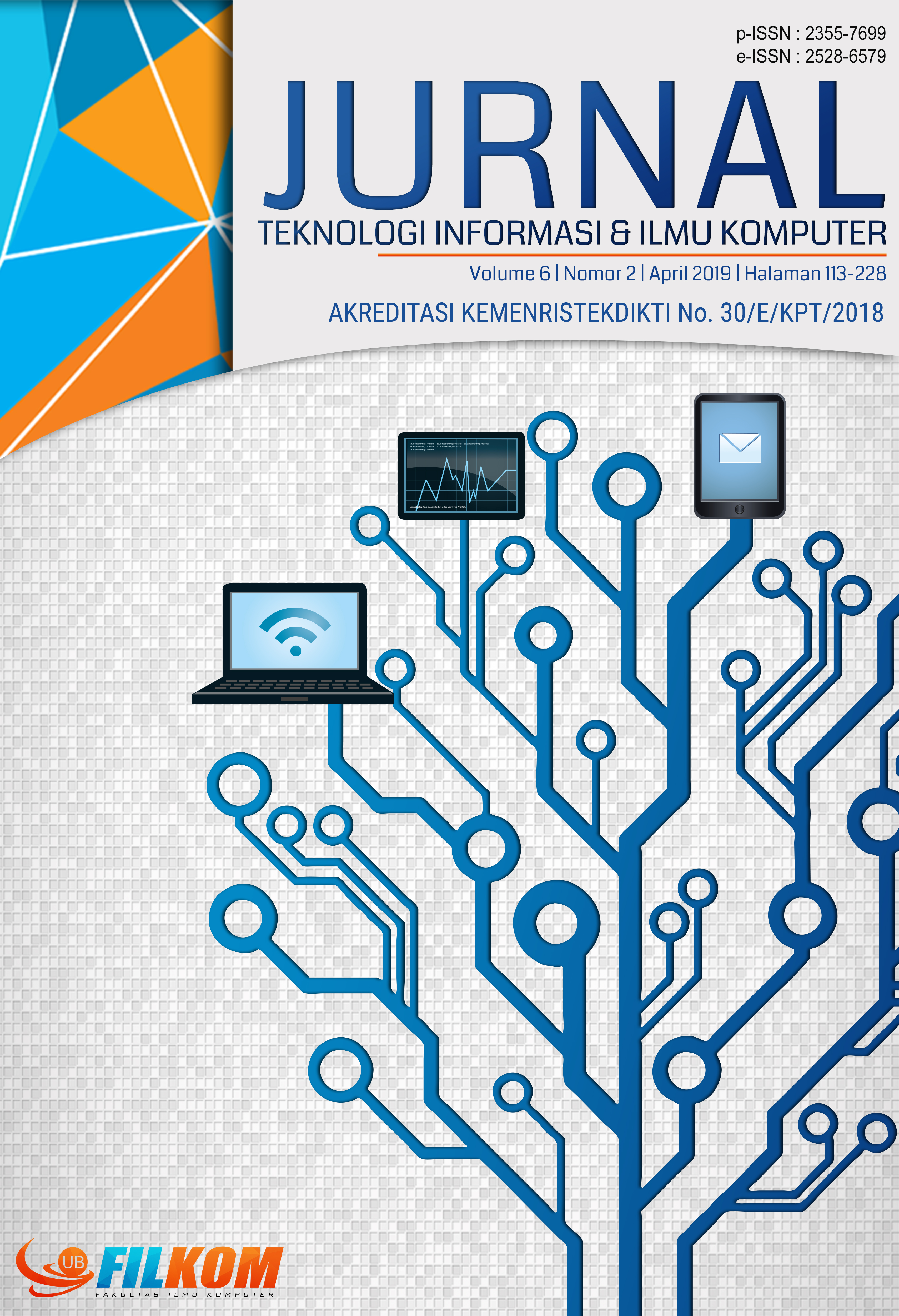Penilaian Penerimaan Teknologi E-Learning Pemrograman berbasis Gamification dengan Metode Technology Acceptance Model (TAM)
DOI:
https://doi.org/10.25126/jtiik.2019621288Abstrak
E-learning telah berkembang tidak hanya sekedar berbagi materi pembelajaran melalui internet, namun telah berevolusi menjadi tempat untuk kolaborasi, sosialisasi, project based learning, reflective practise, dan pembelajaran dengan simulasi. Untuk mewujudkan hal tersebut telah dikembangkan sebuah sistem e-learning gamification khusus bidang pemrograman. Penelitian ini menerapkan Technology Acceptance Model (TAM) untuk memeriksa faktor-faktor apa saja yang berpengaruh terhadap penerimaan sebuah teknologi baru yang diperkenalkan atau digunakan. Faktor-faktor yang digunakan dalam penelitian ini adalah Perceived Usefullness (PU), Perceived Ease of Use (PEU), Perceived Social Influence (PSI), Perceived Enjoyment (PE), Intention of Engagement (IoE), dan Elearning Gamification Attitude (EGA). Model TAM didasarkan beberapa hipotesis dan faktor yang berpengaruh. Hasil menunjukan bahwa TAM dapat digunakan untuk memeriksa penerimaan teknologi e-learning gamification bidang pemrograman. Perceived Social Influence (PSI) dan Perceived Enjoyment (PE) berkontribusi terhadap Intention of Engagement (IOE). Selain itu Perceived Usefullnes (PU), Perceived Social Influence (PSI), Perceived Enjoyment (PE), dan Intention of Engagement (IOE) berkontribusi terhadap Elearning Gamification Attitude (EGA).
Abstract
E-learning has evolved not only to share learning materials over the internet, but has evolved into a place for collaboration, socialization, project based learning, reflective practice, and simulated learning. To realize this has been developed a special e-learning gamification system in the field of programming. This study applies Technology Acceptance Model (TAM) to examine what factors influence the acceptance of a new technology introduced or used. The factors used in this study are Perceived Usefullness (PU), Perceived Ease of Use (PEU), Perceived Social Influence (PSI), Perceived Enjoyment (PE), Intention of Engagement (IoE), and Elearning Gamification Attitude (EGA) . The TAM model is based on several hypotheses and influencing factors. The results show that TAM can be used to check the acceptance of e-learning gamification technology in the field of programming. Perceived Social Influence (PSI) and Perceived Enjoyment (PE) contribute to the Intention of Engagement (IOE). In addition Perceived Usefullnes (PU), Perceived Social Influence (PSI), Perceived Enjoyment (PE), and Intention of Engagement (IOE) contribute to Elearning Gamification Attitude (EGA).
Downloads
Referensi
BACHTIAR, F.A., RACHMADI, A. DAN PRADANA, F., 2014. Acceptance in the Deployment of Blended Learning as Learning Resource in Information Technology and Computer Science Program, Brawijaya University. Asia-Pacific Conference on Computer Aided System Engineering (APCASE), hal.131–135.
BEDRULE-GRIGORUŢĂ, M.V. DAN RUSU, M.-L., 2014. Considerations about E-learning Tools for Adult Education. Procedia - Social and Behavioral Sciences, [daring] 142, hal.749–754. Tersedia pada: <http://linkinghub.elsevier.com/retrieve/pii/S1877042814045388>.
BENBASAT, I. DAN BARKI, H., 2007. Quo vadis TAM? Journal of the Association for Information Systems, [daring] 8(4), hal.211–218. Tersedia pada: <https://aisel.aisnet.org/jais/vol8/iss4/16/>.
CHEN, S.-C., LIU, M.-L. DAN LIN, C.-P., 2013. Integrating Technology Readiness into the Expectation–Confirmation Model: An Empirical Study of Mobile Services. Cyberpsychology, Behavior, and Social Networking, [daring] 16(8), hal.604–612. Tersedia pada: <http://online.liebertpub.com/doi/abs/10.1089/cyber.2012.0606>.
DAVIS, F.D., 1989. Perceived Usefulness, Perceived Ease of Use, and User Acceptance of Information Technology. MIS Quarterly, [daring] 13(3), hal.319. Tersedia pada: <http://www.jstor.org/stable/249008?origin=crossref>.
DAVIS, F.D., 1993. User acceptance of information technology: system characteristics, user perceptions and behavioral impacts. International Journal of Man-Machine Studies, .
LEGRIS, P., INGHAM, J. DAN COLLERETTE, P., 2003. Why do people use information technology? A critical review of the technology acceptance model. Information & Management, [daring] 40(3), hal.191–204. Tersedia pada: <http://linkinghub.elsevier.com/retrieve/pii/S0378720601001434>.
MASROM, M., 2007. Technology Acceptance Model and E-learning Maslin Masrom. [daring] (May), hal.1–10. Tersedia pada: <http://eprints.utm.my/5482/>.
PARK, S., 2009. An analysis of the technology acceptance model in understanding university students’ behavioral intention to use e-learning. Journal of Educational Technology & Society, 12(3), hal.150–162.
POPOVICI, A. DAN MIRONOV, C., 2015. Students’ Perception on Using eLearning Technologies. Procedia - Social and Behavioral Sciences, [daring] 180(November 2014), hal.1514–1519. Tersedia pada: <http://linkinghub.elsevier.com/retrieve/pii/S1877042815016468>.
PRADANA, F., BACHTIAR, F.A. DAN PRIYAMBADHA, B., 2018. Pengaruh Elemen Gamification Terhadap Hasil Belajar Siswa Pada E-Learning Pemrograman Java. Semnasteknomedia, (February), hal.7–12.
RAMAYAH, T. DAN IGNATIUS, J., 2005. Impact of Perceived usefulness , Perceived ease of use and Perceived Enjoyment on Intention to Shop Online. ICFAI Journal of Systems Management (IJSM), [daring] hal.1–16.
Tersedia pada: <http://ramayah.com/journalarticlespdf/impactpeu.pdf>.
SIMÕES, J., REDONDO, R.D. DAN VILAS, A.F., 2013. A social gamification framework for a K-6 learning platform. Computers in Human Behavior, 29(2), hal.345–353.
URH, M., VUKOVIC, G., JEREB, E. DAN PINTAR, R., 2015. The Model for Introduction of Gamification into E-learning in Higher Education. Procedia - Social and Behavioral Sciences, [daring] 197(February), hal.388–397. Tersedia pada: <http://linkinghub.elsevier.com/retrieve/pii/S1877042815041555>.
YANG, Y., ASAAD, Y. DAN DWIVEDI, Y., 2017. Examining the impact of gamification on intention of engagement and brand attitude in the marketing context. Computers in Human Behavior, [daring] 73, hal.459–469. Tersedia pada:<http://dx.doi.org/10.1016/j.chb.2017.03.
Unduhan
Diterbitkan
Terbitan
Bagian
Lisensi

Artikel ini berlisensi Creative Common Attribution-ShareAlike 4.0 International (CC BY-SA 4.0)
Penulis yang menerbitkan di jurnal ini menyetujui ketentuan berikut:
- Penulis menyimpan hak cipta dan memberikan jurnal hak penerbitan pertama naskah secara simultan dengan lisensi di bawah Creative Common Attribution-ShareAlike 4.0 International (CC BY-SA 4.0) yang mengizinkan orang lain untuk berbagi pekerjaan dengan sebuah pernyataan kepenulisan pekerjaan dan penerbitan awal di jurnal ini.
- Penulis bisa memasukkan ke dalam penyusunan kontraktual tambahan terpisah untuk distribusi non ekslusif versi kaya terbitan jurnal (contoh: mempostingnya ke repositori institusional atau menerbitkannya dalam sebuah buku), dengan pengakuan penerbitan awalnya di jurnal ini.
- Penulis diizinkan dan didorong untuk mem-posting karya mereka online (contoh: di repositori institusional atau di website mereka) sebelum dan selama proses penyerahan, karena dapat mengarahkan ke pertukaran produktif, seperti halnya sitiran yang lebih awal dan lebih hebat dari karya yang diterbitkan. (Lihat Efek Akses Terbuka).












